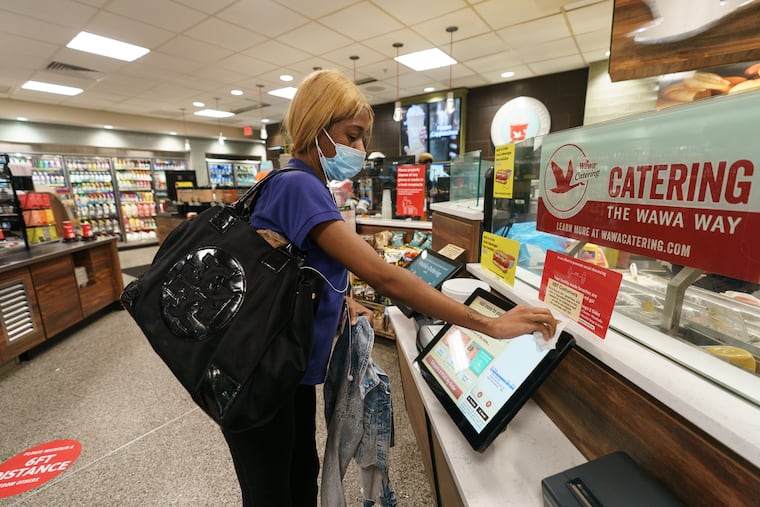No, coronavirus won’t kill the touchscreen
Industry leaders and experts say touchscreens aren’t going away, but instead will likely become just one option for consumers to order food or check out items.

Wawa’s food ordering touchscreens have become a familiar part of life in Philadelphia, with customers taking turns to tap the devices and order hoagies.
But could the coronavirus doom the touchscreen kiosks that were widely adopted by Wawa, banks, airports, and retail stores?
“There is this underlying emotional, physical reaction now to touching stuff,” said Munir Mandviwalla, a Temple professor of management information systems. “The longer this goes on, the more I think people will be afraid of touching things.”
Still, industry leaders and experts say the touchscreens aren’t going away. Instead, they will likely become just one option for consumers to order food or check out items. Companies are encouraging customers to use mobile devices to make contactless purchases, while software developers are designing systems that can be controlled by voice or gesture. Meanwhile, businesses are deploying a low-tech solution to make consumers comfortable: free disinfecting wipes.
Wawa is installing wipe dispensers near touchscreens and sanitizing surfaces at least hourly, spokesperson Lori Bruce said. Wawa is also experimenting with curbside ordering, she said, which was launched last week in two stores, at Center Square in Whitpain Township and Ewing Township, N.J. The convenience store chain has seen its volume of mobile orders double recently, Bruce said.
“Mobile ordering is picking up considerably,” said Alex Baloga, president and CEO of the Pennsylvania Food Merchants Association, a trade group that represents more than 800 supermarket and convenience store operators. “[Stores] are expanding their apps to allow for that mobile ordering. They're encouraging delivery. They're partnering with those third-party services. So, it's really an all-inclusive, all-encompassing approach.”
» READ MORE: Will we ever work in the company office again?
Shoppers are increasingly paying without touching terminals, cash, or credit cards. In April, Mastercard said it saw a 40% jump in contactless payments during the first quarter of this year. That includes tap-to-pay and mobile pay, in which customers hold devices near card readers.
Although the pandemic has made Americans leery of high-touch surfaces — from door handles to elevator buttons — the coronavirus spreads primarily through close person-to-person contact, according to the Centers for Disease Control and Prevention. Kiosks are one way to limit customers’ interaction with other people, said Craig Allen Keefner, manager of the Kiosk Manufacturers Association, based in Denver.
“I think probably the key thing is that person-to-person interaction is being minimized,” he said. “There's all these different input delivery mechanisms, but the one thing in common is that they eliminate the people.”
For example, kiosk software developers are designing terminals that can be controlled by gestures using built-in cameras, or on mobile devices by scanning a code shown on touchscreens, Keefner said. Developers are redesigning interfaces to require fewer touches to complete transactions, too.
“In a post-COVID world, the need for touchless technology, even in self-service, is increasing,” said Brian Whitney, vice president of sales at Appetize, a point-of-sale software developer that lists the Philadelphia Eagles as one of its clients. “We are focused on new technologies to make it easier for customers to use self-service, including ways for them to use it in a touchless environment.”
Voice technology is another possibility, with consumers increasingly inviting Alexa, Siri, and other virtual assistants into their homes. There are still limitations to the technology, especially in crowded spaces, experts said. But voice-controlled displays were starting to catch on at medical facilities before the pandemic because they’re environments that are ripe for the transfer of viruses, said Sean Matthews, CEO of Visix, an Atlanta-based digital signage software company.
Visix, which has a sales office in Malvern, released software in May that lets digital signs, such as mall directory maps, respond to voice commands. In announcing the product, the company noted the recent “concern about germ transmission.”
“This certainly accelerates its adoption,” Matthews said of the pandemic. He said clients have shown interest in voice-controlled interactive maps and room-booking systems since the coronavirus swept through the country.
At Philadelphia International Airport, airlines and other partners have introduced mobile apps that let travelers avoid kiosks for certain tasks, such as in-app boarding passes, said Heather Redfern, an airport spokesperson.
American Airlines, which accounts for nearly 70% of the airport’s traffic, said it regularly cleans kiosks and has turned off some of the devices to make more space between customers, company spokesperson Andrew Trull said. The airline is exploring technology improvements, including to its mobile app, to “make it a touchless experience,” he added.
But experts said touchscreens are unlikely to disappear from stores, even though companies may be less inclined to invest in kiosks in the short term. Concerns over touching surfaces could be solved by basic precautions, such as regularly washing your hands.
“Looking at the CDC guides, surface contamination risk for transmission is relatively low,” said Paul Benda, senior vice president of risk and cyber security policy at the American Bankers Association. “Don’t be afraid of your ATM.”